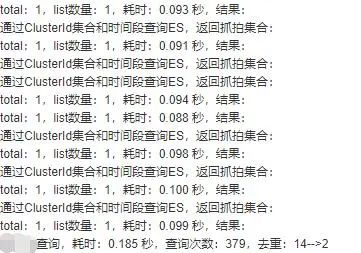前些天写了两篇关于C# async await异步的博客:通过一个示例形象地理解C# async await异步
第一篇博客看的人多,点赞评论也多,我想应该都看懂了,比较简单。
第二篇博客看的人少,点赞的也少,没有评论。
我很纳闷,第二篇博客才是重点,如此吊炸天的代码,居然没人评论。
博客中的代码,就是.NET圈的顶级大佬也没有写过,为什么这么说?这就要说到C# async await的语法糖了:
没有语法糖,代码一样写,java8没有语法糖,一样能写出高性能代码。但有了C# async await语法糖,水平一般的普通的业务程序员,哪怕很菜,也能写出高性能高吞吐量的代码,这就是意义!.
所以我说顶级大佬没写过,因为他们水平高,脑力好,手段多,自然不需要这么写。但对于普通程序来说,代码写的复杂了,麻烦不说,BUG频出。
标题我用了"探索"这个词,有没有更好的实践,让小白们都会写的并行异步的实践?
ElasticSearch的性能
代码的实用价值,是查询es。
最近发现es的性能非常好!先给大家看个控制台输出的截图。服务我是部署在服务器上的,真实环境,不是自己电脑。
379次es查询,仅需0.185秒,当然耗时会有波动,零点几秒都是正常的,超过1秒也有可能。
es最怕的是什么,是慢查询,是条件复杂的查询,是范围查询。
我的策略是多次精确查询,这样可以利用es极高的吞吐能力。
有多快?
上述截图只是其中一个测试,查询分析的时间范围较小(一个多月的数据量)
另一个服务接口,分析半年的数据量,大约72亿+18亿=90亿,从这些数据中分析出结果,仅需大约3-6秒。
为什么这么快?
es群集的服务器较多,内存很大(300G,当然服务器上不只有es),群集本身的吞吐量很高。
并行异步性能高且吞吐量大!而C#语法糖使得并行异步容易编写。
并行异步
既然查询次数多,单线程或者说同步肯定是不行的,必须并行。
并行代码,python能写吗?java能写吗?肯定能啊!
但我前同事写的python多次查询es写的就是同步代码,为什么不并行呢?并行肯定可以写,但是能不写就不写,为什么?因为写起来复杂,不好写。你以为自己技术好,脑力好没问题,但别人呢?
重点是什么?不仅要写并行代码,还要写的简单,不破坏代码原有逻辑结构。
异步方法
大家都会写的,用async await就行了,很简单,放个我写的,代码主要是在双循环中多次异步请求(大致看一下先跳过):
/// <summary>/// xxx查询/// </summary>public async Task<List<AccompanyInfo>> Query2(string strStartTime, string strEndTime, int kpCountThreshold, int countThreshold, int distanceThreshold, int timeThreshold, List<PeopleCluster> peopleClusterList){List<AccompanyInfo> resultList = new List<AccompanyInfo>();Stopwatch sw = Stopwatch.StartNew();//创建字典Dictionary<string, PeopleCluster> clusterIdPeopleDict = new Dictionary<string, PeopleCluster>();foreach (PeopleCluster peopleCluster in peopleClusterList){foreach (string clusterId in peopleCluster.ClusterIds){if (!clusterIdPeopleDict.ContainsKey(clusterId)){clusterIdPeopleDict.Add(clusterId, peopleCluster);}}}int queryCount = 0;Dictionary<string, AccompanyInfo> dict = new Dictionary<string, AccompanyInfo>();foreach (PeopleCluster people1 in peopleClusterList){List<PeopleFeatureInfo> peopleFeatureList = await ServiceFactory.Get<PeopleFeatureQueryService>().Query(strStartTime, strEndTime, people1);queryCount++;foreach (PeopleFeatureInfo peopleFeatureInfo1 in peopleFeatureList){DateTime capturedTime = DateTime.ParseExact(peopleFeatureInfo1.captured_time, "yyyyMMddHHmmss", CultureInfo.InvariantCulture);string strStartTime2 = capturedTime.AddSeconds(-timeThreshold).ToString("yyyyMMddHHmmss");string strEndTime2 = capturedTime.AddSeconds(timeThreshold).ToString("yyyyMMddHHmmss");List<PeopleFeatureInfo> peopleFeatureList2 = await ServiceFactory.Get<PeopleFeatureQueryService>().QueryExcludeSelf(strStartTime2, strEndTime2, people1);queryCount++;if (peopleFeatureList2.Count > 0){foreach (PeopleFeatureInfo peopleFeatureInfo2 in peopleFeatureList2){string key = null;PeopleCluster people2 = null;string people2ClusterId = null;if (clusterIdPeopleDict.ContainsKey(peopleFeatureInfo2.cluster_id.ToString())){people2 = clusterIdPeopleDict[peopleFeatureInfo2.cluster_id.ToString()];key = $"{string.Join(",", people1.ClusterIds)}_{string.Join(",", people2.ClusterIds)}";}else{people2ClusterId = peopleFeatureInfo2.cluster_id.ToString();key = $"{string.Join(",", people1.ClusterIds)}_{string.Join(",", people2ClusterId)}";}double distance = LngLatUtil.CalcDistance(peopleFeatureInfo1.Longitude, peopleFeatureInfo1.Latitude, peopleFeatureInfo2.Longitude, peopleFeatureInfo2.Latitude);if (distance > distanceThreshold) continue;AccompanyInfo accompanyInfo;if (dict.ContainsKey(key)){accompanyInfo = dict[key];}else{accompanyInfo = new AccompanyInfo();dict.Add(key, accompanyInfo);}accompanyInfo.People1 = people1;if (people2 != null){accompanyInfo.People2 = people2;}else{accompanyInfo.ClusterId2 = people2ClusterId;}AccompanyItem accompanyItem = new AccompanyItem();accompanyItem.Info1 = peopleFeatureInfo1;accompanyItem.Info2 = peopleFeatureInfo2;accompanyInfo.List.Add(accompanyItem);accompanyInfo.Count++;resultList.Add(accompanyInfo);}}}}resultList = resultList.FindAll(a => (a.People2 != null && a.Count >= kpCountThreshold) || a.Count >= countThreshold);//去重int beforeDistinctCount = resultList.Count;resultList = resultList.DistinctBy(a =>{string str1 = string.Join(",", a.People1.ClusterIds);string str2 = a.People2 != null ? string.Join(",", a.People2.ClusterIds) : string.Empty;string str3 = a.ClusterId2 ?? string.Empty;StringBuilder sb = new StringBuilder();foreach (AccompanyItem item in a.List){var info2 = item.Info2;sb.Append($"{info2.camera_id},{info2.captured_time},{info2.cluster_id}");}return $"{str1}_{str2}_{str3}_{sb}";}).ToList();sw.Stop();string msg = $"xxx查询,耗时:{sw.Elapsed.TotalSeconds:0.000} 秒,查询次数:{queryCount},去重:{beforeDistinctCount}-->{resultList.Count}";Console.WriteLine(msg);LogUtil.Info(msg);return resultList;}
异步方法的并行化
上述代码是没有问题的,但也有问题。就是在双循环中多次请求,虽然用了async await,但不是并行,耗时会很长,如何优化?请看如下代码:
/// <summary>/// xxx查询/// </summary>public async Task<List<AccompanyInfo>> Query(string strStartTime, string strEndTime, int kpCountThreshold, int countThreshold, int distanceThreshold, int timeThreshold, List<PeopleCluster> peopleClusterList){List<AccompanyInfo> resultList = new List<AccompanyInfo>();Stopwatch sw = Stopwatch.StartNew();//创建字典Dictionary<string, PeopleCluster> clusterIdPeopleDict = new Dictionary<string, PeopleCluster>();foreach (PeopleCluster peopleCluster in peopleClusterList){foreach (string clusterId in peopleCluster.ClusterIds){if (!clusterIdPeopleDict.ContainsKey(clusterId)){clusterIdPeopleDict.Add(clusterId, peopleCluster);}}}//组织第一层循环taskDictionary<PeopleCluster, Task<List<PeopleFeatureInfo>>> tasks1 = new Dictionary<PeopleCluster, Task<List<PeopleFeatureInfo>>>();foreach (PeopleCluster people1 in peopleClusterList){var task1 = ServiceFactory.Get<PeopleFeatureQueryService>().Query(strStartTime, strEndTime, people1);tasks1.Add(people1, task1);}//计算第一层循环task并缓存结果,组织第二层循环taskDictionary<string, Task<List<PeopleFeatureInfo>>> tasks2 = new Dictionary<string, Task<List<PeopleFeatureInfo>>>();Dictionary<PeopleCluster, List<PeopleFeatureInfo>> cache1 = new Dictionary<PeopleCluster, List<PeopleFeatureInfo>>();foreach (PeopleCluster people1 in peopleClusterList){List<PeopleFeatureInfo> peopleFeatureList = await tasks1[people1];cache1.Add(people1, peopleFeatureList);foreach (PeopleFeatureInfo peopleFeatureInfo1 in peopleFeatureList){DateTime capturedTime = DateTime.ParseExact(peopleFeatureInfo1.captured_time, "yyyyMMddHHmmss", CultureInfo.InvariantCulture);string strStartTime2 = capturedTime.AddSeconds(-timeThreshold).ToString("yyyyMMddHHmmss");string strEndTime2 = capturedTime.AddSeconds(timeThreshold).ToString("yyyyMMddHHmmss");var task2 = ServiceFactory.Get<PeopleFeatureQueryService>().QueryExcludeSelf(strStartTime2, strEndTime2, people1);string task2Key = $"{strStartTime2}_{strEndTime2}_{string.Join(",", people1.ClusterIds)}";tasks2.TryAdd(task2Key, task2);}}//读取第一层循环task缓存结果,计算第二层循环taskDictionary<string, AccompanyInfo> dict = new Dictionary<string, AccompanyInfo>();foreach (PeopleCluster people1 in peopleClusterList){List<PeopleFeatureInfo> peopleFeatureList = cache1[people1];foreach (PeopleFeatureInfo peopleFeatureInfo1 in peopleFeatureList){DateTime capturedTime = DateTime.ParseExact(peopleFeatureInfo1.captured_time, "yyyyMMddHHmmss", CultureInfo.InvariantCulture);string strStartTime2 = capturedTime.AddSeconds(-timeThreshold).ToString("yyyyMMddHHmmss");string strEndTime2 = capturedTime.AddSeconds(timeThreshold).ToString("yyyyMMddHHmmss");string task2Key = $"{strStartTime2}_{strEndTime2}_{string.Join(",", people1.ClusterIds)}";List<PeopleFeatureInfo> peopleFeatureList2 = await tasks2[task2Key];if (peopleFeatureList2.Count > 0){foreach (PeopleFeatureInfo peopleFeatureInfo2 in peopleFeatureList2){string key = null;PeopleCluster people2 = null;string people2ClusterId = null;if (clusterIdPeopleDict.ContainsKey(peopleFeatureInfo2.cluster_id.ToString())){people2 = clusterIdPeopleDict[peopleFeatureInfo2.cluster_id.ToString()];key = $"{string.Join(",", people1.ClusterIds)}_{string.Join(",", people2.ClusterIds)}";}else{people2ClusterId = peopleFeatureInfo2.cluster_id.ToString();key = $"{string.Join(",", people1.ClusterIds)}_{string.Join(",", people2ClusterId)}";}double distance = LngLatUtil.CalcDistance(peopleFeatureInfo1.Longitude, peopleFeatureInfo1.Latitude, peopleFeatureInfo2.Longitude, peopleFeatureInfo2.Latitude);if (distance > distanceThreshold) continue;AccompanyInfo accompanyInfo;if (dict.ContainsKey(key)){accompanyInfo = dict[key];}else{accompanyInfo = new AccompanyInfo();dict.Add(key, accompanyInfo);}accompanyInfo.People1 = people1;if (people2 != null){accompanyInfo.People2 = people2;}else{accompanyInfo.ClusterId2 = people2ClusterId;}AccompanyItem accompanyItem = new AccompanyItem();accompanyItem.Info1 = peopleFeatureInfo1;accompanyItem.Info2 = peopleFeatureInfo2;accompanyInfo.List.Add(accompanyItem);accompanyInfo.Count++;resultList.Add(accompanyInfo);}}}}resultList = resultList.FindAll(a => (a.People2 != null && a.Count >= kpCountThreshold) || a.Count >= countThreshold);//去重int beforeDistinctCount = resultList.Count;resultList = resultList.DistinctBy(a =>{string str1 = string.Join(",", a.People1.ClusterIds);string str2 = a.People2 != null ? string.Join(",", a.People2.ClusterIds) : string.Empty;string str3 = a.ClusterId2 ?? string.Empty;StringBuilder sb = new StringBuilder();foreach (AccompanyItem item in a.List){var info2 = item.Info2;sb.Append($"{info2.camera_id},{info2.captured_time},{info2.cluster_id}");}return $"{str1}_{str2}_{str3}_{sb}";}).ToList();//排序foreach (AccompanyInfo item in resultList){item.List.Sort((a, b) => -string.Compare(a.Info1.captured_time, b.Info1.captured_time));}sw.Stop();string msg = $"xxx查询,耗时:{sw.Elapsed.TotalSeconds:0.000} 秒,查询次数:{tasks1.Count + tasks2.Count},去重:{beforeDistinctCount}-->{resultList.Count}";Console.WriteLine(msg);LogUtil.Info(msg);return resultList;}
上述代码说明
为了使异步并行化,双循环要写三遍。第一遍只需写第一层循环,省了第二层。第二遍没有数据处理的那层子循环。第三遍是最全的。
和普通的异步相比,第一、二遍双循环是多出来的,第三遍双循环代码结构和普通的异步代码结构是一样的。
写的时候,可以先写好普通的异步方法,然后再改造成并行化的异步方法。
你为什么说.NET圈的顶级大佬没有写过?
不吹个牛,博客没人看,没人点赞啊?!
牛B的是C#,由于C#语法糖,把牛B的代码写简单了,才是真的牛B。
我倒是希望有大佬写个更好的实践,把我这种写法淘汰掉,因为这是我能想到的最容易控制的写法了。
并行代码,很多人都会写,java、python也能写,但问题是,比较菜的普通业务程序员,如何无脑写这种并行代码?
最差的写法,例如java的CompletableFuture,结合业务代码,写法就很复杂了。真的没法无脑写。
其次的写法,例如:
List<PeopleFeatureInfo>[] listArray = await Task.WhenAll(tasks2.Values);在双循环体中,怎么拿结果?肯定能写,但又要思考怎么写了不是?
而我的写法,在双循环体中是可以直接拿结果的:
List<PeopleFeatureInfo> list = await tasks2[task2Key];只放C#代码没有说服力,我一个同事python写的很6,他写的挖掘代码很多都是并行,放一段代码:
def get_es_multiprocess(index_list, people_list, core_percent, rev_clusterid_idcard_dict):'''多进程读取es数据,转为整个数据帧,按时间排序:return: 规模较大的数据帧'''col_list = ["cluster_id", "camera_id", "captured_time"]pool = Pool(processes=int(mp.cpu_count() * core_percent))input_list = [(i, people_list, col_list) for i in index_list]res = pool.map(get_es, input_list)if not res:return Nonepool.close()pool.join()df_all = pd.DataFrame(columns=col_list+['longitude', 'latitude'])for df in res:df_all = pd.concat([df_all, df])# 这里强制转换为字符串!df_all['cluster_id_'] = df_all['cluster_id'].apply(lambda x: rev_clusterid_idcard_dict[str(x)])del df_all['cluster_id']df_all.rename(columns={'cluster_id_': 'cluster_id'}, inplace=True)df_all.sort_values(by='captured_time', inplace=True)print('=' * 100)print('整个数据(聚类前):')print(df_all.info())cluster_id_list = [(i, df) for i, df in df_all.groupby(['cluster_id'])]cluster_id_list_split = [j for j in func(cluster_id_list, 1000000)]# todo 缩小数据集,用于调试!data_all = df_all.iloc[:, :]return data_all, cluster_id_list_split
上述python代码解析
核心代码:
res = pool.map(get_es, input_list)pool.join()...省略
其中get_es是查询es的方法,他写的应该不是异步方法,不过这个不是重点
2. res是查询结果,通过并行的方式一把查出来,放到res中,然后把结果再解出来
3. 注意,这只是单循环,想想双层循环怎么写
4. pool.join()是阻塞当前线程的,这个不好
5. 同事注释中写的是"多进程",是写错了吗?实际是多线程?还是就是多进程?
6. 当然,python是有async await异步写法的,应该不比C#差,只是同事没有用,可能是因为他用的python版本不够新
7. python代码,字符串太多,字符串是最不好维护的。C#中的字符串里面都是强类型。
把脑力活变成体力活
照葫芦画瓢,把脑力活变成体力活,我又写了一个方法(业务逻辑不重要,看并行异步的使用):
/// <summary>/// xxx查询/// </summary>public async Task<List<SameVehicleInfo>> Query(string strStartTime, string strEndTime, int kpCountThreshold, int timeThreshold, List<PeopleCluster> peopleClusterList){List<SameVehicleInfo> resultList = new List<SameVehicleInfo>();Stopwatch sw = Stopwatch.StartNew();//组织第一层循环task,查xxxDictionary<PeopleCluster, Task<List<PeopleFeatureInfo>>> tasks1 = new Dictionary<PeopleCluster, Task<List<PeopleFeatureInfo>>>();foreach (PeopleCluster people1 in peopleClusterList){var task1 = ServiceFactory.Get<PeopleFeatureQueryService>().Query(strStartTime, strEndTime, people1);tasks1.Add(people1, task1);}//计算第一层循环task并缓存结果,组织第二层循环task,精确搜xxxDictionary<string, Task<List<MotorVehicleInfo>>> tasks2 = new Dictionary<string, Task<List<MotorVehicleInfo>>>();Dictionary<PeopleCluster, List<PeopleFeatureInfo>> cache1 = new Dictionary<PeopleCluster, List<PeopleFeatureInfo>>();foreach (PeopleCluster people1 in peopleClusterList){List<PeopleFeatureInfo> peopleFeatureList = await tasks1[people1];cache1.Add(people1, peopleFeatureList);foreach (PeopleFeatureInfo peopleFeatureInfo1 in peopleFeatureList){string task2Key = $"{peopleFeatureInfo1.camera_id}_{peopleFeatureInfo1.captured_time}";var task2 = ServiceFactory.Get<MotorVehicleQueryService>().QueryExact(peopleFeatureInfo1.camera_id, peopleFeatureInfo1.captured_time);tasks2.TryAdd(task2Key, task2);}}//读取第一层循环task缓存结果,计算第二层循环taskDictionary<PersonVehicleKey, PersonVehicleInfo> dictPersonVehicle = new Dictionary<PersonVehicleKey, PersonVehicleInfo>();foreach (PeopleCluster people1 in peopleClusterList){List<PeopleFeatureInfo> peopleFeatureList = cache1[people1];foreach (PeopleFeatureInfo peopleFeatureInfo1 in peopleFeatureList){string task2Key = $"{peopleFeatureInfo1.camera_id}_{peopleFeatureInfo1.captured_time}";List<MotorVehicleInfo> motorVehicleList = await tasks2[task2Key];motorVehicleList = motorVehicleList.DistinctBy(a => a.plate_no).ToList();foreach (MotorVehicleInfo motorVehicleInfo in motorVehicleList){PersonVehicleKey key = new PersonVehicleKey(people1, motorVehicleInfo.plate_no);PersonVehicleInfo personVehicleInfo;if (dictPersonVehicle.ContainsKey(key)){personVehicleInfo = dictPersonVehicle[key];}else{personVehicleInfo = new PersonVehicleInfo(){People = people1,PlateNo = motorVehicleInfo.plate_no,List = new List<PeopleFeatureInfo>()};dictPersonVehicle.Add(key, personVehicleInfo);}personVehicleInfo.List.Add(peopleFeatureInfo1);}}}//比对xxxList<PersonVehicleKey> keys = dictPersonVehicle.Keys.ToList();Dictionary<string, SameVehicleInfo> dict = new Dictionary<string, SameVehicleInfo>();for (int i = 0; i < keys.Count - 1; i++){for (int j = i + 1; j < keys.Count; j++){var key1 = keys[i];var key2 = keys[j];var personVehicle1 = dictPersonVehicle[key1];var personVehicle2 = dictPersonVehicle[key2];if (key1.PlateNo == key2.PlateNo){foreach (PeopleFeatureInfo peopleFeature1 in personVehicle1.List){double minTimeDiff = double.MaxValue;int minIndex = -1;for (int k = 0; k < personVehicle2.List.Count; k++){PeopleFeatureInfo peopleFeature2 = personVehicle2.List[k];DateTime capturedTime1 = DateTime.ParseExact(peopleFeature1.captured_time, "yyyyMMddHHmmss", CultureInfo.InvariantCulture);DateTime capturedTime2 = DateTime.ParseExact(peopleFeature2.captured_time, "yyyyMMddHHmmss", CultureInfo.InvariantCulture);var timeDiff = Math.Abs(capturedTime2.Subtract(capturedTime1).TotalSeconds);if (timeDiff < minTimeDiff){minTimeDiff = timeDiff;minIndex = k;}}if (minIndex >= 0 && minTimeDiff <= timeThreshold * 60){PeopleCluster people1 = key1.People;PeopleCluster people2 = key2.People;PeopleFeatureInfo peopleFeatureInfo2 = personVehicle2.List[minIndex];string key = $"{string.Join(",", people1.ClusterIds)}_{string.Join(",", people2.ClusterIds)}"; ;SameVehicleInfo accompanyInfo;if (dict.ContainsKey(key)){accompanyInfo = dict[key];}else{accompanyInfo = new SameVehicleInfo();dict.Add(key, accompanyInfo);}accompanyInfo.People1 = people1;accompanyInfo.People2 = people2;SameVehicleItem accompanyItem = new SameVehicleItem();accompanyItem.Info1 = peopleFeature1;accompanyItem.Info2 = peopleFeatureInfo2;accompanyInfo.List.Add(accompanyItem);accompanyInfo.Count++;resultList.Add(accompanyInfo);}}}}}resultList = resultList.FindAll(a => a.Count >= kpCountThreshold);//筛选,排除xxxresultList = resultList.FindAll(a =>{if (string.Join(",", a.People1.ClusterIds) == string.Join(",", a.People2.ClusterIds)){return false;}return true;});//去重int beforeDistinctCount = resultList.Count;resultList = resultList.DistinctBy(a =>{string str1 = string.Join(",", a.People1.ClusterIds);string str2 = string.Join(",", a.People2.ClusterIds);StringBuilder sb = new StringBuilder();foreach (SameVehicleItem item in a.List){var info2 = item.Info2;sb.Append($"{info2.camera_id},{info2.captured_time},{info2.cluster_id}");}return $"{str1}_{str2}_{sb}";}).ToList();//排序foreach (SameVehicleInfo item in resultList){item.List.Sort((a, b) => -string.Compare(a.Info1.captured_time, b.Info1.captured_time));}sw.Stop();string msg = $"xxx查询,耗时:{sw.Elapsed.TotalSeconds:0.000} 秒,查询次数:{tasks1.Count + tasks2.Count},去重:{beforeDistinctCount}-->{resultList.Count}";Console.WriteLine(msg);LogUtil.Info(msg);return resultList;}
